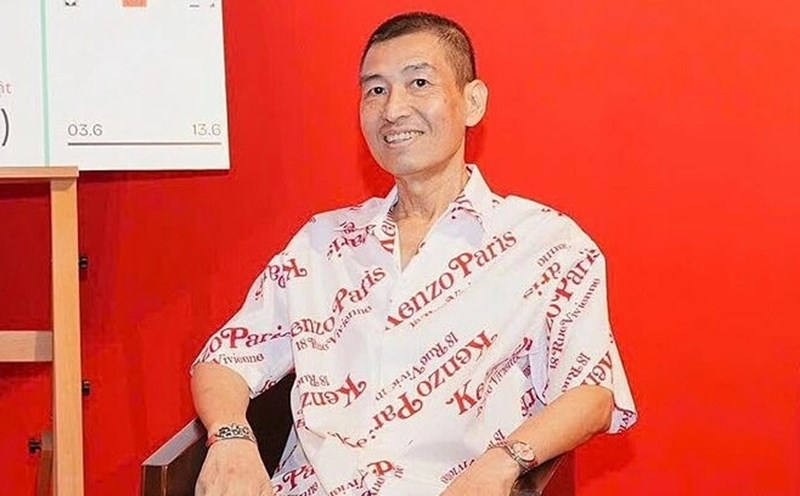The book is how Le Thiet Cuong tells how he feels about the small, hidden beauty in the flow of time, from the house to the street, from ancient times to the present. He looked, smelled, tasteled, touched, listened, then recounted through the lines.
Reading "The Market" must be chosen while being relaxed, otherwise it is difficult to feel the slow, meticulous rhythm in it. Those who see the beauty in lotus starch, in lotus smoke, those who taste every suitable spice of each dish, those who describe "mother's stele", " kitchen stele", "Tet stele", the footsteps of street vendors, " market stele" ... are certainly slow-witted people, in the sense of living deeply and carefully, like appreciating and regretting all the beautiful things in this life.
Saying so is not Le Thiet Cuong praising expensive and elaborate things. He spoke about the burnt pieces, the fish sauce cup, the right season green rice wrapping displayed in the gift stall... as much as he appreciated it when talking about paintings by famous artists and artists, a scene that evokes memories, a suitable pottery item. What he cares about and wants to recount is the elaborate details and emotions accumulated in a dish, an object, an atmosphere, which he believes that the small things make the housework, the soul of the city.
The things that Le Thiet Cuong cares about and values become rare in this busy era, readers may exclaim in some places, why is it so meticulous and "difficult"? But sometimes in limited circumstances, the attention to small details is a sign of a serious attitude that is passionate about life.
Just like Le Thiet Cuong always remembers the smell of cinnamon cake his mother gave him when he had to return to his hometown to evacuate, during which Hanoi was often bombed. "Mother is cinnamon cake, the aroma of mother is cinnamon cake... like a cinnamon cake from fifty years ago has a different, thick flavor that is difficult to name. The taste of hunger? The bomb? The taste of distance, of tears?". During the time of buying food, you have to follow the standard stamp, the mother's cinnamon cake has flour, sugar, sugar and cinnamon powder, and is then brought to her children over a journey of more than a hundred kilometers.
He paid attention to how dishes and spices go together: I dont know what to say, I thought that living simply would be easy, but... eating shrimp paste and sweet star fruit would be easy to swallow. Not to mention that some households have replaced it with pineapple, so the table is free. The story of star fruit and shrimp paste continues. Star fruit is used to eat shrimp paste, so you have to cut it into pieces (even as a cross), and star fruit is used to roast shrimp. But star fruit for cooking fish soup is also a long-lasting member. Thai is prone to pruning according to each dish, even if it is just a spice, it is very important for those who know how to eat it. Suppose the bowl of fish soup is sour, even if the star fruit is sour, looking at the star fruit will not be pleasing to the eye. The spices of shrimp paste also include green bananas, green onions, and diced ginger. It is also ginger but the bowl of boiled snail dipping sauce or sour with collard greens and fish sauce makes the ginger crumble. Grilled pepper is used in many dishes, but for pigs ( stir-fried pigs), it must be grated pepper.... Old Quarter Beef Beef Beef Beef only at Hang Muoi is hand-shaped rice noodles, delicious and beautiful because the noodles are not regular and not thicker than the machine, so the two edges of the noodles are curved up, looking pleasing to the eye".
" reading "Length of the market", people know that Le Thiet Cuong is modern. Modern is not about reforming the form, in the elaborate arrangement, but in the way Mr. Cuong permeates the tradition - wrapping the quintessence in each daily contemporary operation.
Reading "Shopping flute", people also know that Le Thiet Cuong is minimalist. Is food, speech - speech - not the basic cultural units of a person, a land or something? Mr. Cuong likes to look for aesthetic signs right in such a seemingly disjointed and simple part of life" - Tre Publishing House wrote in the preface.
It can be seen that even if Le Thiet Cuong eats, dresses, takes photos, draws, invites you to a drinking party... he still pays attention to the beauty. He said: "Beauty is a human thing. Of course, eating also requires learning. Learning to eat, learning to speak, learning to live beautifully".
"The market" tells many stories about cooking in the kitchen, but more broadly, it is depiction, so a Le Thiet Cuong is very willing to spend time and effort to meticulously observe and reflect on something that he thinks is beautiful, without any concern for whether it is " worthy" of spending time and effort from the general public's point of view or not? Although that beauty is so quiet that it is difficult for anyone to notice.
"Shopping Journal" shows Le Thiet Cuong's lifestyle, likes things that are natural, favorable according to things he is interested in, rich in feelings, even if short, it is nothing. He told me about a friend from abroad who came back and was invited by him to buy a package of green rice at a street vendor. She found it delicious and a few days later asked him to buy it as a gift. He said it was not easy to buy, because of the deliciousness of green rice, the goodness of Hanoi, because there are such street vendors, "no restaurant specializes in selling green rice. But it is called a gift, eating gifts means eating and playing, eating when convenient, just come back to visit, eating gifts at the right time, eating without a meal".
Painter and writer Le Thiet Cuong was born in 1962 and died in July 2025.
After graduating from Hanoi University of Theatre and Cinema (class 1985 - 1990), artist Le Thiet Cuong began his independent creative journey. He soon affirmed his name not only because of his best-selling paintings over the past 3 decades but also because of his steadfast, profound artistic mindset and unique creative style. In addition to holding a palm, he is also a pen about art that is loved by the public.
Le Thiet Cuong is one of the pioneer artists who bring abstract and minimalist art to Vietnamese painting since the early 1990s. He boldly broke the old patterns, creating a new form of shaping, rich in identity and containing depth of Eastern philosophy. The combination of simple shapes, minimalist colors - mainly black and white and traditional topics such as chopsticks, oil lamps, lotus lamps, buffaloes ... helped him shape his own style, unique and full of meditation.
Not only painting, Le Thiet Cuong always takes time to write. After the books "Seeing" 2017 and "People and House" (2024), in June 2025, he continued to release " chatting with painting". Literature and painting by Le Thiet Cuong are concise, concise but meticulous and profound.
The book "Tieng Cho" was his last work published by Tre Publishing House.











